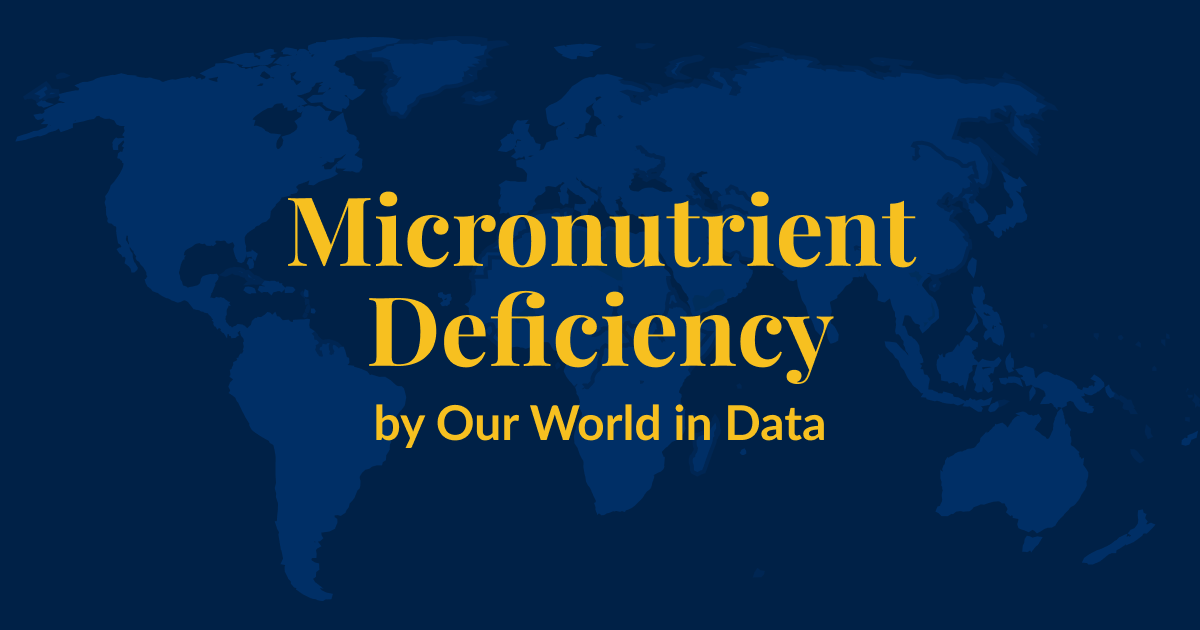Obesity
When did obesity increase? How do rates vary across the world? What is the health impact?
This page was first published in August 2017 and last revised in January 2024.
Obesity is a major risk factor for a range of diseases, including heart disease, stroke, diabetes, and various types of cancer.
It is most commonly measured using the body mass index (BMI) scale.
On this page, you will find global data and research on obesity — its prevalence, drivers, health consequences, and trends over time.
See all interactive charts on Obesity ↓
Related topics:

Food Supply
How had the availability of food changed over time? How does food supply vary across the world today?
Hunger and Undernourishment
How does undernourishment vary across the world? How has it changed over time?

Micronutrient Deficiency
Food is not only a source of energy and protein, but also micronutrients — vitamins and minerals — which are essential to good health. Who is most affected by the "hidden hunger" of micronutrient deficiency?
Other research and writing on obesity on Our World in Data:
What is obesity?
Obesity is commonly measured using the Body Mass Index (BMI) scale
Obesity can be measured in different ways, but the most common is the Body Mass Index (BMI) scale, which is calculated based on a person’s height and weight.
BMI is defined as their weight in kilograms divided by the square of their height in meters (kg/m2).1
BMI values are used to define whether an individual is considered to be underweight, healthy, overweight, or obese.
In adults, the WHO defines these categories using the cut-off points: an individual with a BMI between 25 and 30 is considered "overweight", while a BMI greater than 30 is defined as "obese".2 However, different cut-off points are used for other groups, such as children and pregnant women.
Read more in our article:
What is obesity and how is it measured?
Obesity is a leading risk factor for poor health outcomes. How is obesity defined and measured?
Obesity is one of the leading risk factors for early death
Obesity is responsible for millions of premature deaths each year
Obesity is one of the world's largest health problems — one that has shifted from being a problem in rich countries to a health challenge around the world.
The Global Burden of Disease is a major global study on the causes and risk factors for death and disease.3 The authors of the study have estimated the annual number of deaths attributed to a wide range of risk factors, as you can see below.
Obesity — defined as having a high body mass index — is a risk factor for several of the world's leading causes of death, including heart disease, stroke, diabetes, and various types of cancer.4
As you can see, it’s estimated that around 5 million people died prematurely in 2019 as a result of obesity, which makes it one of the leading causes of death worldwide.
Read more in our article:

How do researchers estimate the death toll caused by each risk factor, whether it’s smoking, obesity, or air pollution?
Risk factors are important to understand because they can help us identify how to save lives. How do researchers estimate their impact?
The global distribution of health impacts from obesity
What share of global deaths are the result of obesity?
Globally, it’s estimated that almost 10% in 2019 resulted from the consequences of obesity — this was almost double the share in 1990.
This share varies significantly across the world. In the map here we see the share of deaths attributed to obesity across countries.
Across many middle-income countries — such as in Eastern Europe, Central Asia, North Africa, and Latin America — more than 15% of deaths were attributed to obesity in 2019.
This results from both a high prevalence of obesity, as well as poorer overall health and healthcare systems compared to high-income countries with similarly high levels of obesity.
In 2019, in most high-income countries, the share of deaths attributed to obesity was in the range of 8 to 10%. In many middle-income countries, this share was almost twice as high.
In contrast, across several low-income countries — especially across Sub-Saharan Africa — it’s estimated that obesity accounts for under 5% of deaths.
There is a large difference in death rates from obesity across the world
Death rates from obesity can also help us understand differences in the impact of obesity between countries and over time.
In the map here you can see differences in death rates from obesity across the world, per 100,000 people in the population.
Death rates tend to be higher in Eastern Europe, Central Asia, North Africa, and Latin America.
In contrast, they tend to be much lower in Western Europe, Australia, and East Asia.
When we look at the relationship between death rates and the prevalence of obesity we find a positive one: death rates tend to be higher in countries where more people are obese.
But what we also notice is that for a given prevalence of obesity, death rates can vary by a factor of four. While around a quarter of people in Russia and Norway are obese, death rates in Russia are much higher.
It's not only the prevalence of obesity that plays a role but also other factors — such as underlying health, other confounding risk factors (such as alcohol, drugs, smoking, and other lifestyle factors), and healthcare systems.
What share of adults are obese?
Obesity varies widely worldwide and has become more common
In the chart here, we see the share of adults (aged 18 years and older) who are obese across regions. These estimates are based on survey data and statistical modeling by the World Health Organization (WHO).
Overall we see a pattern roughly in line with prosperity: the prevalence of obesity tends to be higher in richer countries across Europe, North America, and Oceania. Obesity rates tend to be much lower across South Asia and Sub-Saharan Africa.
More than a third of adults in the United States were obese in 2016. In countries such as India and Nigeria, that share was far lower.
The chart also shows the share of adults who are obese has grown over time.

Obesity in men vs. women
See the data in our interactive visualization
What share of adults are overweight?
Globally, it’s estimated that around two-fifths of adults were overweight or obese in 2016.4
The classification of "overweight" is also defined based on the body-mass index — it refers to BMI values between 25 and 30.
In the map here we see the share of adults who are overweight or obese across countries.
As you can see, the share of people who are overweight tends to be higher in richer countries and lower in poorer countries.
In many high-income countries such as the United States, it’s estimated that over 60% of adults are overweight or obese.
In contrast, across South Asia and Sub-Saharan Africa, it’s estimated that around one in five adults are overweight or obese.

Share of women who are overweight or obese
See the data in our interactive visualization
Body Mass Index (BMI)
Mean BMI in adult women
In the map, here we see the distribution of average (mean) BMI in adult women across the world.
In 2016, the global average (mean) BMI in women was around 25, which is the cut-off for overweight. The average BMI tends to be higher in North and South America and North Africa, and lower in sub-Saharan Africa and Asia.
Mean BMI in adult men
In the map here we see the distribution of mean BMI for adult men across the world.
In 2016, the global average (mean) BMI in men was estimated to be around 25, which is the cut-off for overweight. The average BMI tends to be higher in North and South America and North Africa, and lower in sub-Saharan Africa and Asia.
Childhood obesity
Share of children that are overweight
Obesity and overweight in children are also measured based on body mass index (BMI).
However, BMI scores are interpreted differently for children and adolescents.
Weight categories are defined by comparing weight to the WHO Growth Standards — a child is defined as overweight if their weight-for-height is more than two standard deviations from the median of the WHO Child Growth Standards.4
What are the drivers of obesity?
At a basic level, weight gain — eventually leading to being overweight or obesity — is determined by a balance of energy.5
When we consume more energy — typically measured in calories — than the energy expended to maintain life and carry out daily activities, we gain weight. This is called an “energy surplus”. When we consume less energy than we expend, we lose weight — this is an “energy deficit”.
This means there are two potential drivers of the increase in obesity rates in recent decades — either we eat more (an increase in calorie intake) or we expend less energy in our daily life through lower activity levels. Both elements are likely to play a role in the rise in obesity.
To tackle obesity, interventions that address both energy intake and expenditure are important.6
Daily supply of calories
Over the past century — but particularly over the past 50 years — the supply of calories has increased across the world.
In the 1960s, the global average supply of calories (that is, the availability of calories for people to eat) was around 2,200 kcal per person per day. By 2013, this had increased to 2800kcal.
Across most countries, energy consumption has therefore increased. Without an increase in energy expenditure, weight gain and obesity tend to rise.
In the chart here, we see the relationship between the share of men who are overweight or obese versus the daily average supply of kilocalories per person.
Overall there is a strong positive relationship: countries with higher rates of overweight tend to have a higher supply of calories.
If you press "play" on the interactive timeline you can see how this has changed for each country over time. Countries tend to move upwards and to the right: the supply of calories has increased as obesity rates have increased.
Is BMI an appropriate measure of weight-related health?
The merits of using BMI as an indicator of body fat and obesity are contested.
A key contention to the use of BMI indicators is that it is a measure of body mass/weight rather than providing a direct measure of body fat.
Whilst physicians continue to use BMI as a general indicator of weight-related health risks, there are some cases where its use should be considered more carefully, which are listed below, and physicians are recommended to evaluate BMI results carefully on an individual basis.7
- Muscle mass can increase body weight; this means athletes or individuals with a high muscle mass percentage can be deemed overweight on the BMI scale, even if they have a low or healthy body fat percentage;
- Muscle and bone density tends to decline as we get older; this means that an older individual may have a higher percentage body fat than a younger individual with the same BMI;
- Women tend to have a higher body fat percentage than men for a given BMI.
Read more in our article:
What is obesity and how is it measured?
Obesity is a leading risk factor for poor health outcomes. How is obesity defined and measured?
Endnotes
For example, an adult who weighs 70kg and whose height is 1.75m will have a BMI of 22.9. This is calculated as 70kg / 1.752 = 70 / 3.06 = 22.9
World Health Organization. BMI Classification. Global Database on Body Mass Index. Available online.
The latest study can be found at the website of the Lancet here: TheLancet.com/GBD
The 2017 study was published as GBD 2017 Risk Factor Collaborators — "Global, regional, and national comparative risk assessment of 84 behavioural, environmental and occupational, and metabolic risks or clusters of risks for 195 countries and territories, 1990-2017: a systematic analysis for the Global Burden of Disease Study 2017" and is online here.
WHO (2018) — Fact sheet — Obesity and overweight. Updated February 2018. Online here.
Hall, K. D., Heymsfield, S. B., Kemnitz, J. W., Klein, S., Schoeller, D. A., & Speakman, J. R. (2012). Energy balance and its components: implications for body weight regulation. The American Journal of Clinical Nutrition, 95(4), 989-994. Available online.
Hill, J. O., Wyatt, H. R., & Peters, J. C. (2012). Energy balance and obesity. Circulation, 126(1), 126-132.
Centers for Disease Control and Prevention. Body Mass Index: Considerations for Practitioners. Available online.
Cite this work
Our articles and data visualizations rely on work from many different people and organizations. When citing this topic page, please also cite the underlying data sources. This topic page can be cited as:
Hannah Ritchie and Max Roser (2017) - “Obesity” Published online at OurWorldInData.org. Retrieved from: 'https://ourworldindata.org/obesity' [Online Resource]BibTeX citation
@article{owid-obesity,
author = {Hannah Ritchie and Max Roser},
title = {Obesity},
journal = {Our World in Data},
year = {2017},
note = {https://ourworldindata.org/obesity}
}Reuse this work freely
All visualizations, data, and code produced by Our World in Data are completely open access under the Creative Commons BY license. You have the permission to use, distribute, and reproduce these in any medium, provided the source and authors are credited.
The data produced by third parties and made available by Our World in Data is subject to the license terms from the original third-party authors. We will always indicate the original source of the data in our documentation, so you should always check the license of any such third-party data before use and redistribution.
All of our charts can be embedded in any site.























